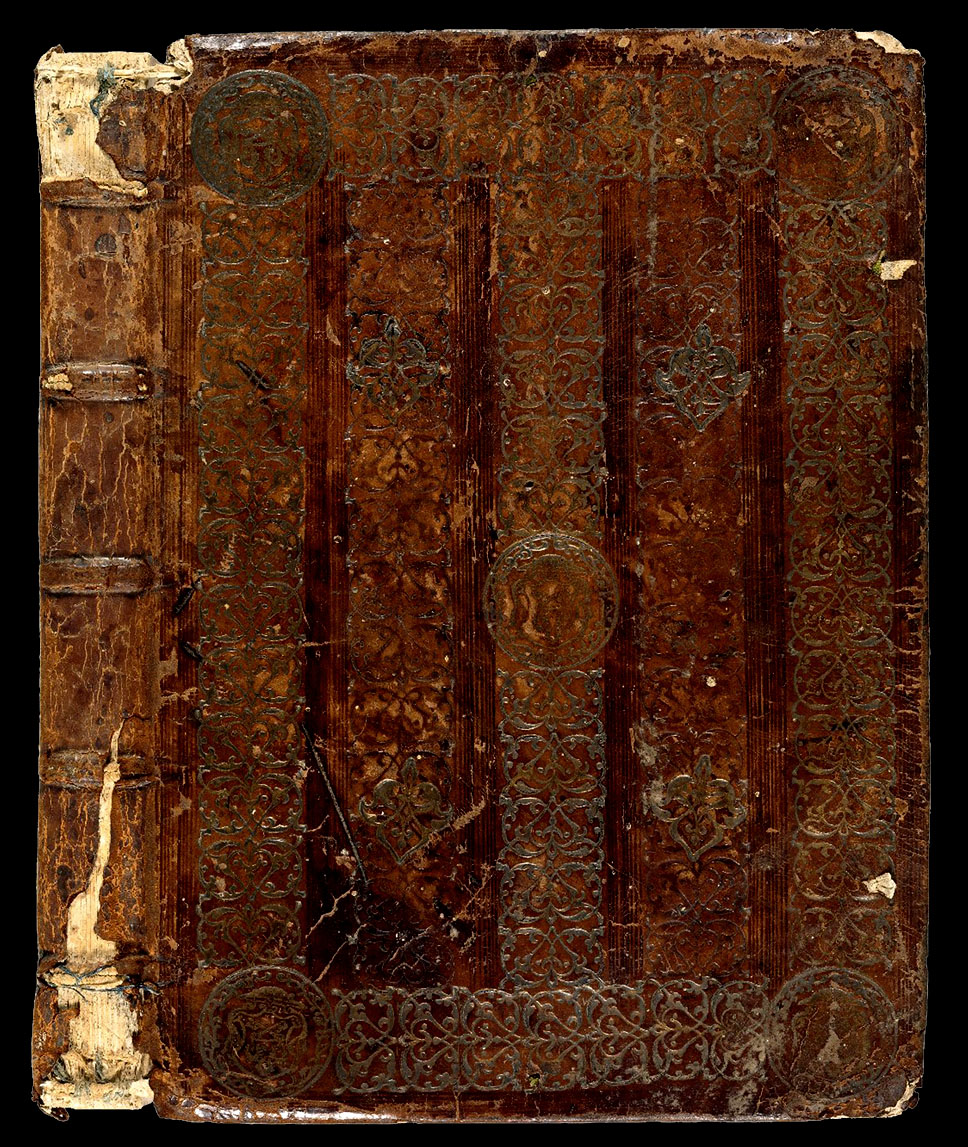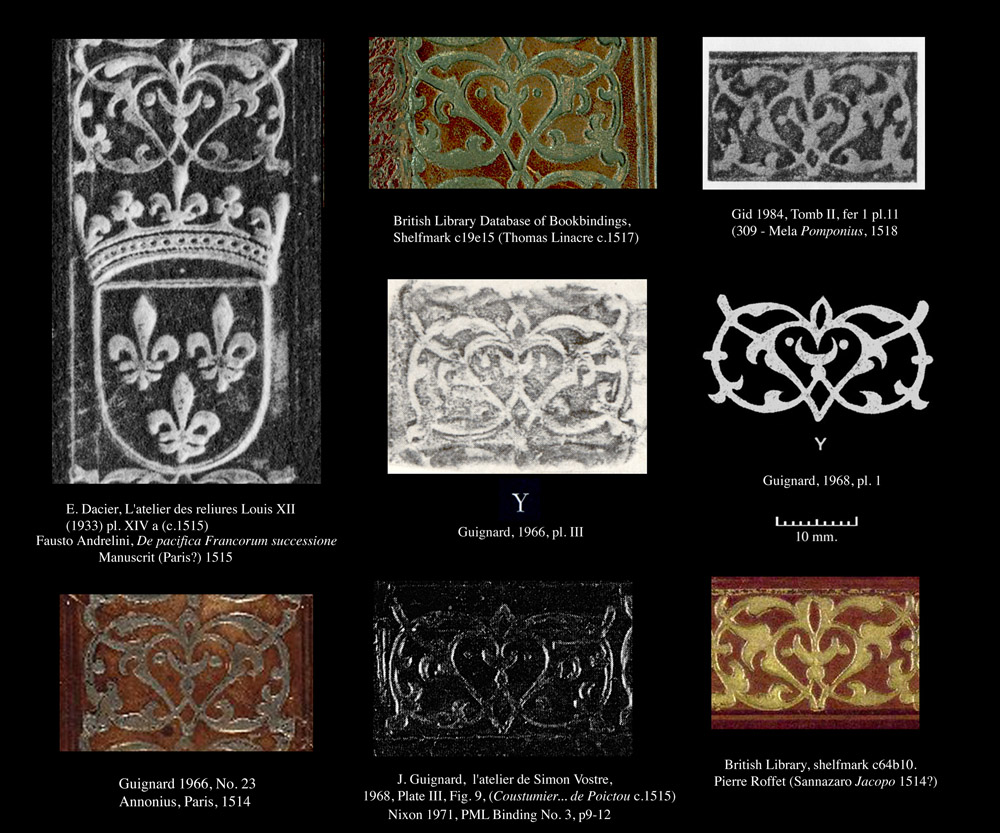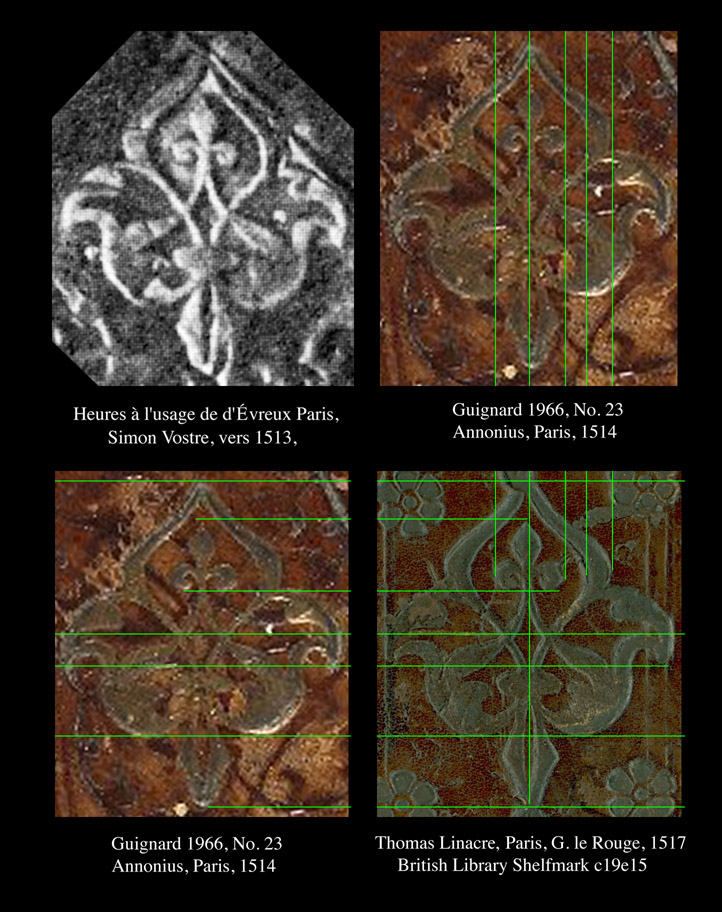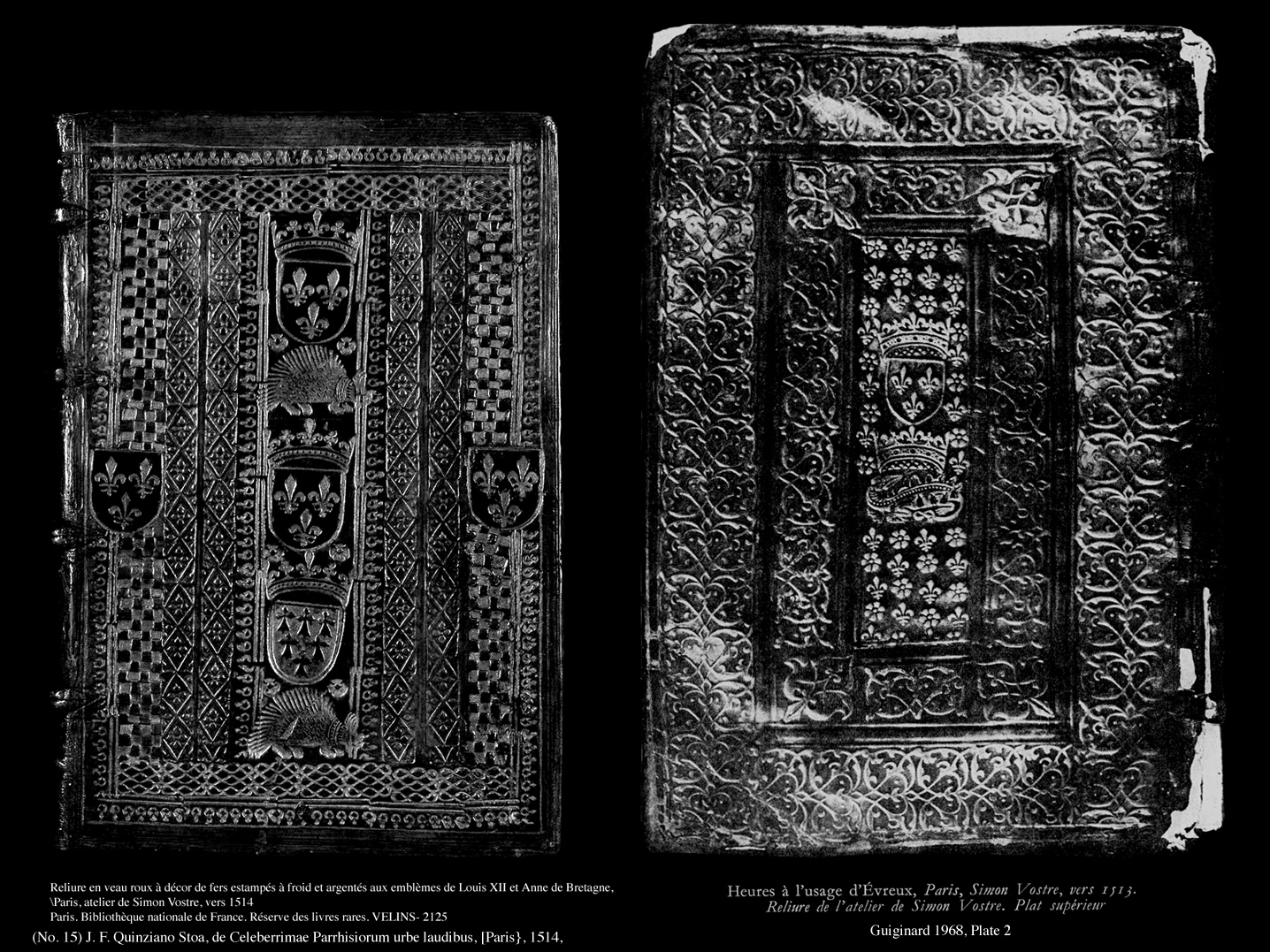


| My interest in bindings from this atelier became a sort of obsession after I happened to buy one on Ebay. It turns out that these bindings are very rare, and the atelier intensively researched by a number of specialists. In his 1971 book Sixteenth-century Gold-tooled Bookbindings in the Pierpont Morgan Library Howard M. Nixon presents a binding under the heading of (3) Paris Binding by the Louis XII-François I Bindery, c. 1515. (shown in our inventory as No. 22). In his description of this binding, Nixon gives a brief explanation of the various theories concerning this atelier at that time: |
| In his article in Les Trésors des bibliothèques de France fasc. XVII, Émile Dacier wrote of this bindery as the 'Atelier des reliures Louis XII'. He pointed out that the court of Louis XII was usually at Blois, nearly all the authors of books bound in this shop were connected with the Court, and the workshop of these books was not up to the standard reached by the blind-tooled leather bindings of the Parisian workshops. From these facts he went on to suggest that the atelier was situated at Blois, although he pointed out that there was no documentary evidence of its existence, and Michon adopted this suggestion and wrote in La Reliure française of the 'atelier de Blois', the Blois bindery. This was convenient, since it acknowledged the fact that there was some bindings produced in this shop after the death of Louis XII, which occurred on the night of 31 December 1514-1 January 1515. Unfortunately it seems more than doubtful whether Dacier's location of this atelier at Blois can be justified. His argument from the low standard of workmanship disregarded the fact that this was the first bindery to make a regular practice of gold-tooling in France and that gold-tooling needs much more skill than tooling a roll, or impressing an engraved panel in blind. The skill exhibited in the French blind-tooled leather bindings is that of the engraver of the tools rather than the finisher. In this series of bindings tooled in gold - and apparently sometimes silver - the finisher had to grapple with the problem of heating the finishing tool to exactly the correct heat, to cause the gold leaf to adhere securely in the impression, without getting it too hot, which would burn the leather. Dacier thought that the shop only continued to work until the end of 1515 but it seems to have continued in action until at least 1519. Thomas Linacre, classical scholar and Henry VIII's physician, presented in that year copies on vellum of his Paris-printed translation of Galens's Methodus medendi to both his royal master and to Cardinal Wolsey. Both are clearly bound in this same shop, as is a similar vellum copy of Galen's De sanitate tuenda, 1517, also translated by Linacre and presented by him to Wolsey. (1) This latter has the fleur-de-lis roll found on the Morgan Coustumier de Poictou in addition to the linked circle tool, which was not used in the reign of Louis XII, but appears on all three Linacre books and on a 1494 Speculum historiale of Vincint de Beauvais at Rodez described by Michon. (2) This Speculum has the same large capitals as the Henry VIII Methodus medendi and the crown, shield with the arms of France, salamander and rosette found on the Morgan binding... |
|
here we must interrupt Nixon to object to his statement "Dacier thought that the shop only continued to work until the end of 1515 but it seems to have continued in action until at least 1519. Thomas Linacre, classical scholar and Henry VIII's physician, presented in that year copies on vellum of his Paris-printed translation of Galens's Methodus medendi to both his royal master and to Cardinal Wolsey. Both are clearly bound in this same shop", Is hardly correct, the Linacre bindings that he mentions show very little relation to the Louis XII bindings from pre 1514, the tools are completely different and most likely derive from another atelier, perhaps the atelier of Simon Vostre if it existed. This is why I have separated these bindings in our inventory (seen on page 2) the whole argument of Nixon clearly bound in the same shop is null and void unless you can show some sort of continuum of tools from the original Louis XII workshop to these post 1515 bindings. The most critical flaw in this argument however is to evoke the "linked circle tool" . This tool appears on No. 27 Fausto Andrelini, De pacifica Francorum successione. Manuscrit (Paris?) 1515, Reliure aux armes de France, Examplaire de dédicace à François Ier. The ecu that makes up the Royal arms is the same as that used on many of the earlier bindings from this workshop and is a distinctive tool from the Louis XII atelier (see a fully detailed description of this ecu). In Comparative Diagram 1, shown below , I have assembled the linked circle tool imprints in question, both Nixon and Guignard made elaborate theories around this tool however we can see in the enlargements that the original tool found in the atelier of Louis XII shown next to the arms of France, and the tool imprint sited by Nixon in the Linacre bindings and also in his binding No. 3 are not exactly the same and thus derive from different tools. Guignard presents (1966) a hastily made, crude rubbing of the Linacre example of this tool, and later in 1968 a fanciful illustration that must stand as the most inaccurate representation of any imprint ever recorded. Which he also claimed to be evident on the bindings Pierre Roffet, however as can be observed in our diagram, the Roffet example is yet another variation of this tool. Both Nixon and Guignard based their theories on this tool, that turns out to be two or three different tools. |

| Now we continue with Nixon's text on this issue as it relates to Guignard: |
| .... In his article in Studia Bibliographica in honorem Herman de la Fontaine Vorwey, Jacques Guignard has brought the total number of bindings from what he calls the 'atelier Louis XII-François Ier' up to thirty-three (3) and is convinced that the bindery was situated in Paris and not in Blois. To my arguments in favor of this, he is able to add that only a dozen at most out of the thirty-three can be connected with the royal family or persons connected with the Court; that in 1516 when the bindery was in its heyday, François Ier paid 19 livres 6s 5 deniers to a certain Etienne Cochart "pour avoir relié et mis au point plusiers livres' of the Blois library and Cochart was a Paris binder; and that waste manuscript leaves used in the boards of two of the bindings in the group connect with Paris rather than Blois. he further suggests that the bindery may have been that of Simon Vostre who in addition to being a publisher of Books of Hours, held the office of 'libraire et relieur-juré de l'University. Vostre died in June 1521, just at the time the tools found on this group ceased to be used. His binding equipment included 'de l'azure" and blue paint is found on the royal arms of several of those books. he also possessed bound books and books to be bound. His shop and tools were taken over by Pierre Roffet. |
|
On the previous page I have shown the Guignard tried to use the same doubtful methods and inaccurate imprint illustrations to show that tool imprints found on the bindings of Pierre Roffet, are the same as found on the Linacre and Annonius bindings, however enlarged examples of this imprint show that the Roffet imprint is a full 3 to 4 millimeters smaller and obviously not the same tool. By as early as 1974 Nixon declaired that Guignard was mistaken and that none of the tools of Simon Vostre i.e. the Louis XII apear in any of Pierre Roffet's bindings. If Guignard is right in assuming that Roffet's tool derives from Vostre's workshop, then we must conclude that the Linacre bindings did not. In the more than 18 years that Simon Vostre was a publisher he produced hundreds of editions of his Books of Hours, how many books then can we image he printed altogether? How many books can today be said to have been bound and decorated in the atelier of Vostre perhaps a dozen, perhaps none? The earliest bindings from the so called atelier of Louis XII contained books that had nothing to do with Vostre, why then would we imagine that they were bound and decorated in the so called atelier of Vostre? If all the bindings derive from Vostre's atelier as proposed by Guignard and the BnF why is there a distinct separation of tools after 1515? The earliest bindings of François Ier bear a different arms, salamander and tools that may have been still in use as late as 1520 or even later. Clearly it seems likely that the bindings shown on page two of our inventory derive from a different atelier. However there is one binding that may help to unravel this mystery. It is shown at the top of this page. When you look closely at the unusual placements and strange angles of the four Eo imprints, one is tempted to guess that these imprints were added sometime later by a not so talented guilder. They are also inverted and have been placed directly over previous work When I was creating the first pages of the inventory in April 2009 I could not find a reproduction of this binding, now by good fortune a scaled reproduction is available online from the Bodleian Library Armed with this reproduction we can extract some precious rare imprint examples and measure them accurately, I show the first of these in Comparative Diagram 1 (lower left corner). The Bodleian description for this binding does not mention Louis XII: One of the earliest French gold-tooled bindings. French (Paris), c.1514. Brown calfskin, tooled in gold and blind with three Italianate tools: a pair of circles, a leaf tool, arms of Cardinal Francesco Soderini (1453-1524) in circle, in centre, and corners. One of a group of bindings associated with the introduction of gold tooling from Italy to France. If you research Cardinal Soderini, you will discover that he had a close connection with Louis XII, in fact he became a Cardinal due to the demand of Louis XII. Le pape Alexandre VI le cré e cardinal lors du consistoire du 31 mai 1503 (publié le 2 juin suivant), sur demande du roi Louis XII de France. Le cardinal Soderini est nommé vêque de Cortona en 1504 et administrateur de Saintes en 1507. Thus we might imagine that Louis XII commissioned this binding for the Cardinal. In any case the imprint of the double circle tool is the same as the one shown directly above it in Comparative Diagram 1, along with the arms of France, this is the original double circle tool from the atelier of Louis XII |

| In Comparative Diagram 2, we see that the various imprints shown may possibly derive from the same tool yet are found on bindings from the two different ateliers, one we might name as the atelier of Simon Vostre in as much as here at last is a binding on a book printed by Vostre. However binding 23 is virtually the only exception to the rule where we can see a possible mixture of tools, yet the BnF have jumped in with both feet and now attribute all the Louis XII bindings to Voste including a binding (VELINS- 2125) shown below in Comparative Diagram 3. this is now their display example of a binding from the atelier Simon Vostre. Obviously this binding has nothing to do with Vostre or his atelier, it derives 100% from the atelier of Louis XII. How can anyone imagine that the two bindings shown below in Comparative Diagram 3, derive from the same supposed atelier of Simon Vostre? Both are dated to about the same period, 1513 or 1514?. Not a single common tool can be found, i.e. one that has been used on both bindings. |

|
Finally we must ask, where is the proof that the so called atelier Simon Vostre ever produced a single gold tooled binding? We know for certain that Pierre Roffet acquired the tools and materials of Simon Vostre, if the atelier of Simon Vostre produced the gold tooled bindings shown in Comparative Diagram 3, why do we not see the imprints of these tools in the later bindings of Roffet? Guignard has discredited himself by presenting fake evidence of these tools however his methods and theories will not stand up to thorough scrutiny (as proved by Nixon 1974, Wingfield). Another unanswered question is why do we find Pierre Roffet using tools that imitate the Louis XII tools if he had already acquired the real tools from Vostre? Vostre was pobably a busy man, who barely had time to bind the numerous books that he published himself, would he have been able to bind books produced by all the other printers as well... "...Pigouchet and Simon Vostre emanated the art of book illustration in France; they worked together for eighteen years, in steady collaboration, and, as far as we know, without a cloud. When Vostre started in business in 1488 he lived in the Rue Neuve Notre Dame, at the sign of St. Jean l'Evangeliste, and in 1520 he was still there, having published more than three hundred editions of the Hours for the use of the several cities." Out of a possible 40 bindings that might be attributed to the Alelier of Louis XII- François Ier, only a handful were printed by Vostre, yet the BnF wants us to believe that all the Louis XII bindings as well as the François Ier bindings were made in the atelier of Simon Vostre and that this bindery was the first to make gold-tooled bindings in France. In the next few pages we are going to look closely at the imprint evidence from the bindings of the post Louis XII period. |
| about the author | VIRTUAL BOOKBINDING |